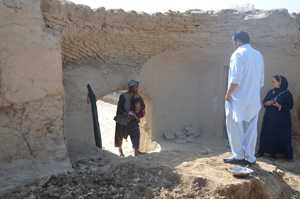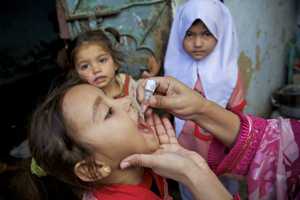This page is a historical archive and is no longer maintained.
For current information, please visit http://www.cdc.gov/media/
Press Release
Embargoed Until: Thursday, November 21, 2013, 1:00 pm ET
Contact:
Media Relations
(404) 639-3286
Progress and Challenges Fighting Polio in Pakistan and Afghanistan
Not reaching every child jeopardizes progress and risks re-introduction in other parts of the world
Both Pakistan and Afghanistan saw an overall decrease in wild poliovirus (WPV) cases from January – September 2013 compared with the same time period in 2012 according to data published in the Morbidity and Mortality Weekly Report (MMWR) released today by the Centers for Disease Control and Prevention (CDC). Since 2012, transmission of indigenous WPV has been limited to three countries: Afghanistan, Pakistan, and Nigeria. Results for Nigeria will be released in December.
Both countries still face significant challenges in reaching unvaccinated children. Afghanistan is fighting a polio outbreak in the Eastern Region while Pakistan continues to see polio increases in the conflict-affected Federally Administered Tribal Areas (FATA), where there is a ban on polio vaccination, and in security-compromised Khyber Pakhtunkhwa Province. The potential risk of transmission to other countries highlights the need for strong ongoing global efforts to eradicate this disease.
“Although there have been setbacks, we are making progress towards global polio eradication,” said CDC Director Dr. Tom Frieden, M.D., M.P.H. “There is encouraging progress in Afghanistan, but, as long as transmission is uninterrupted in Pakistan and Nigeria, the risk for spread to other countries continues because polio anywhere presents a threat of polio everywhere."
In Afghanistan, confirmed cases of WPV dropped from 80 in 2011 to 37 in 2012. The downward trend continues for 2013 with only eight cases confirmed during January–September 2013, compared with 26 during the same period in 2012. All eight polio cases in 2013 were in the Eastern Region and originated from the wild poliovirus in Pakistan.
This week Afghanistan achieved a significant milestone - 12 months without any recorded cases of wild poliovirus in the traditionally polio-endemic provinces of Kandahar and Helmand, long recognized as Afghanistan's epicentres of polio. This unprecedented progress is an endorsement of the effectiveness of the polio eradication programs and their implementation in the Southern Region.
Pakistan reported a decrease from 198 WPV cases throughout the country in 2011 to 58 in 2012 in selected areas. Fifty-two cases were reported during January–September 2013, compared with 54 cases during the same period in 2012. However, because of additional cases since September, 2013 Pakistan has now surpassed the 2012 numbers, thus reversing the downward trend. Eighty-four percent of cases reported since January 2012 occurred in the FATA and Khyber Pakhtunkhwa Province.
Approximately 350,000 children in the FATA have not received polio vaccines during immunization campaigns conducted since mid-2012 because local authorities have banned vaccination. In other areas of Pakistan, polio vaccination teams have encountered increased security threat-levels, hindering immunization programs. Further multi-pronged efforts to reach children in conflict-affected and security-compromised areas will be necessary to prevent WPV re-introduction into other areas of Pakistan and other parts of the world. This situation requires all countries to take additional public health actions to strengthen detection and strengthen protection by enhancing polio surveillance programs and intensifying vaccination efforts.
Get email updates
To receive email updates about this site, enter your email address:
Contact Us:
- Centers for Disease Control and Prevention
1600 Clifton Rd
Atlanta, GA 30333 - 800-CDC-INFO
(800-232-4636)
TTY: (888) 232-6348 - Contact CDC-INFO
 ShareCompartir
ShareCompartir





